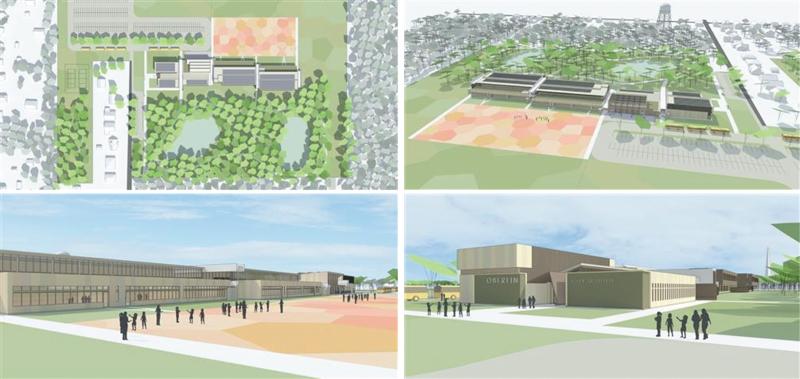School Board to Campaign for Construction Bond
Graphical representations of Oberlin’s potential new school are shown. A bond for constructing a new pre-K through fifth grade school building may be put on the November ballot.
April 1, 2016
After years of deliberation, the Oberlin Board of Education is preparing to vote on a bond issue that would fund the replacement of the Prospect and Eastwood elementary school buildings with a new pre-K through fifth grade facility.
If approved, the roughly $16.5 million bond could find its way onto the November ballot.
The school board originally planned to include the bond in last November’s election but felt the need to address a backlog of other issues first, said Board President Ken Stanley. Both of the district’s renewal levies passed on March 15 by more than two-to-one margins, and the district is looking to capitalize on that momentum by moving forward on the as-yet-unnamed school construction bond.
The district has spent more than three years planning and gathering estimates for the new school building in partnership with the Ohio Facilities Construction Commission, a state agency that assists public schools with construction projects, said Oberlin City Schools superintendent David Hall.
Since all of the district’s school buildings are more than 50 years old and are in need of major upgrades, the district would also consider building a new facility to replace Langston Middle School and Oberlin High School should the bond for the pre-K through fifth grade facility make it to the November ballot and pass.
This is because it is much more cost effective for the district to build a single new school to replace the current elementary buildings than it is to do renovations. The remodeling would involve bringing the more than half-century-old buildings up to code and retrofitting them with the necessary accommodations to comply with the Americans with Disabilities Act requirements.
“It’s so inefficient to renovate that the state wouldn’t even help us with it, we’d get no money from the state,” Stanley said.
The benefit of a construction project is that the state would foot about 20 percent of the bill, Hall said. However, the money would come in the form of a rebate a few years down the line. The state evaluates the construction needs of each school district and proportionally allots funds to the districts that need the most aid.
“The timing of the state funding is a big unknown,” Stanley said, estimating that Oberlin would be able to secure state money for construction anywhere in the next three to eight years. Another reason the district considers
the construction of a new building to be the superior option to renovations is that the schools are poorly configured for 21stcentury needs in general, Stanley said. The buildings are not only energy inefficient, but also inefficient in terms of transportation and personnel costs. Art, music and gym teachers, to name a few, often have to travel between the schools, and they require multiples of the classroom resources that are too large to bring with them, Stanley said.
“These buildings were built at a time when our total school population was 2,000; it’s now about 1,000,” Stanley said. “There would be a lot of operational savings as well as energy savings, and we’d simply get much better space out of it.”
Reducing energy consumption is a point of focus for the board, since investing now in energy-efficient technology will allow the district to cut costs in the long-term.
“We have higher standards for the carbon footprint of the school,” Stanley said. “We would like it to be a net zero, we’re not promising that it will be a net zero, but we will certainly push harder than a lot of districts would to keep our carbon footprint to a minimum.”
The board is looking to have the new pre-K through fifth grade facility built just south of where Oberlin High School is located, partly on district property and partly on property owned by the College, which has offered to sell the land to the district for a nominal price, Stanley said.
Over the next few months, the district will hold public meetings and information sessions, create a campaign website and post videos with further financial and academic information about how the new facility would improve the district, Hall said.
“We understand the complexities of it and understand it’s going to be a challenge, but we want to get the information out to the community, and hopefully they’ll have all the information necessary to make the decision that we do need a new school,” Hall said.
“It will split the community,” Stanley said. “There are people who are very enthusiastic about a new building, for a lot of different reasons, and there are people who really like the old buildings. … Unfortunately, it’s not something that one can really compromise with — either you’re going to build a new building or you’re not, there’s nothing in between.”
The board expects to vote on the bond issue in late May, after scrutinizing the bond’s language and considering community input.
“We plan on getting a lot of information out to the community before the voting time happens,” Hall said.

























